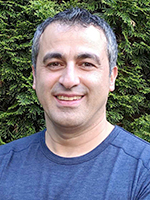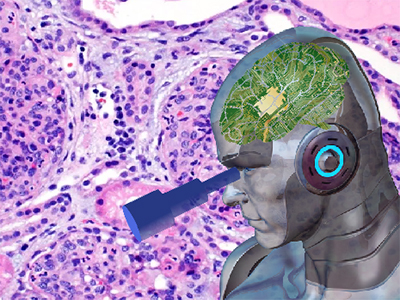
Machine learning to boost genetic medicine in ovarian cancer.
When the human genome was sequenced 20 years ago, there was a great excitement at the possibility of personalized medicine. Once the genetic makeup of a person’s disease was known, hopes were high that researchers could design specifically matched and targeted treatment for many patients. It turns out, dealing with real-world disease is not so straightforward. Now scientists at the Ovarian Cancer Research Centre (OVCARE) are trying to harness the power of artificial intelligence (AI) to enhance personalized medicine. AI is the use of complex computer programs and so-called machine learning to perform analytic tasks that humans would typically do, but at much more accelerated and efficient pace.
Dr. Ali Bashashati is the brains behind the machine learning. He says the powerful ability of AI to reprogram itself to recognize patterns and make predictions on its own is used in applications like Siri and Google assistant, as well as web sites that recommend ads and products based on your previous online activity. Using it in more complex applications to identify cancers and personalize therapies is daunting.

Bashashati says one of the main obstacles to using genome sequencing findings for personalized medicine is the need for specialized tissue collection.
“To have tissue samples that preserve DNA for sequencing, you need to collect them very quickly and preserve them in a special freezing process," says Bashashati. "That’s not widely available and it is costly.”
Routinely collected conventional pathology samples are cheaper and easier to handle, but their DNA is damaged due to the exposure of the tissue to chemicals. Bashashati says this is where AI comes in to bridge the gap: “AI may be able to identify surrogate markers from tissue images that recapitulate genetic patterns, without the need to do complex DNA sequencing.”
"People only hear about the big success stories with AI. It’s an extremely complicated process. However, we are seeing comparable results to general pathologists with our first testing of smaller data sets."
Bashashati says another obstacle to personalized medicine is that tumours don’t exist in isolation. “Identifying the DNA sequence of a tumour is only step one in a long process. You also need to understand how the immune system and surrounding tissue will react to any drug therapy. Those are different in each person, even if they share the same tumour DNA.” Bashashati says AI could be the bridge, by being able to find patterns in surrounding tissue as well.
To date, Bashashati’s computer program has been able to identify the known pathological subtypes of ovarian cancer. He is aiming for more precision—results that would match the accuracy of specialized oncology tests and even improve on them.

“We know we can acquire more than 10,000 ovarian cancer samples from research partners around the world.” Bashashati says that means they need IT infrastructure to store, handle and analyze the massive amounts of data created. They also need to build scalable AI infrastructure to answer specific questions about each cancer and accelerate the translation of findings from bench to bedside.
The data generated for each patient ranges between 2-5 gigabytes. Once processed and analyzed, it takes up to 50 terabytes of storage space, about the same as 15,000 feature films.
BC initiative to broaden the use of AI to study other cancers
AI is on the radar of many health researchers. Since starting his project six months ago, Bashashati has partnered with colleagues from the Vancouver Prostate Center, BC Cancer, part of the Provincial Health Services Authority, and the biomedical and electrical engineering departments at UBC. Together, they have formed a research initiative, called the BC Translational Digital Pathology Initiative. Bashashati says collaboration means potential for systematic breakthroughs on a large scale, instead of small specialized discoveries.
“I don’t like working in silos, in my little cubicle. This cooperation between technical and clinical teams will move us forward to solve relevant real-life questions.”
With his knowledge and skills in AI, Bashashati could easily have gone to work for any number of tech companies, which are rapidly engaging in AI research and applications. But he’s keen to stay in cancer research. “I like to help patients. That’s why I go to work every day. I want to make a lasting contribution with my skillset."
This project is funded by the Carraresi Foundation OVCARE research grant supported by the VGH & UBC Hospital Foundation as well as the Department of Obstetrics & Gynaecology of UBC.


